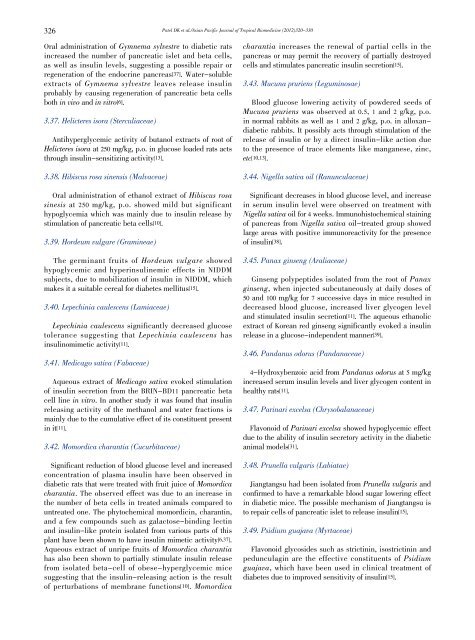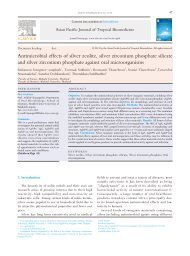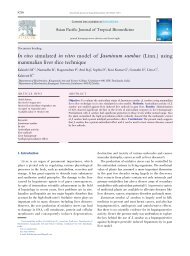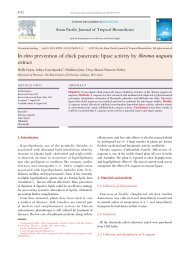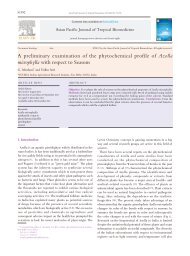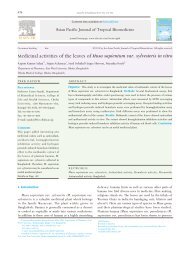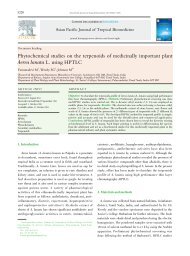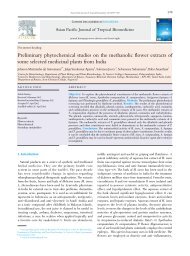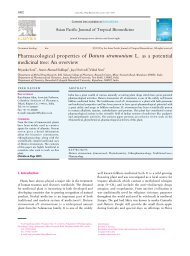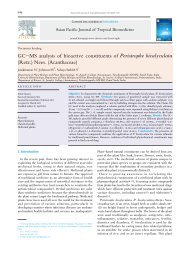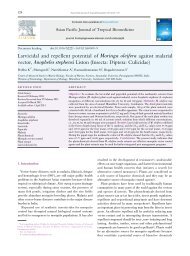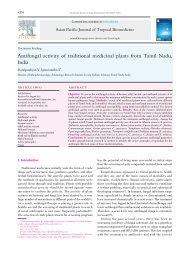An overview on antidiabetic medicinal plants having ... - Apjtb.com
An overview on antidiabetic medicinal plants having ... - Apjtb.com
An overview on antidiabetic medicinal plants having ... - Apjtb.com
Create successful ePaper yourself
Turn your PDF publications into a flip-book with our unique Google optimized e-Paper software.
326<br />
Patel DK et al./Asian Pacific Journal of Tropical Biomedicine (2012)320-330<br />
Oral administrati<strong>on</strong> of Gymnema sylvestre to diabetic rats<br />
increased the number of pancreatic islet and beta cells,<br />
as well as insulin levels, suggesting a possible repair or<br />
regenerati<strong>on</strong> of the endocrine pancreas[37]. Water-soluble<br />
extracts of Gymnema sylvestre leaves release insulin<br />
probably by causing regenerati<strong>on</strong> of pancreatic beta cells<br />
both in vivo and in vitro[6].<br />
3.37. Helicteres isora (Sterculiaceae)<br />
<str<strong>on</strong>g>An</str<strong>on</strong>g>tihyperglycemic activity of butanol extracts of root of<br />
Helicteres isora at 250 mg/kg, p.o. in glucose loaded rats acts<br />
through insulin-sensitizing activity[13].<br />
3.38. Hibiscus rosa sinensis (Malvaceae)<br />
Oral administrati<strong>on</strong> of ethanol extract of Hibiscus rosa<br />
sinesis at 250 mg/kg, p.o. showed mild but significant<br />
hypoglycemia which was mainly due to insulin release by<br />
stimulati<strong>on</strong> of pancreatic beta cells[10].<br />
3.39. Hordeum vulgare (Gramineae)<br />
The germinant fruits of Hordeum vulgare showed<br />
hypoglycemic and hyperinsulinemic effects in NIDDM<br />
subjects, due to mobilizati<strong>on</strong> of insulin in NIDDM, which<br />
makes it a suitable cereal for diabetes mellitus[15].<br />
3.40. Lepechinia caulescens (Lamiaceae)<br />
Lepechinia caulescens significantly decreased glucose<br />
tolerance suggesting that Lepechinia caulescens has<br />
insulinomimetic activity[11].<br />
3.41. Medicago sativa (Fabaceae)<br />
Aqueous extract of Medicago sativa evoked stimulati<strong>on</strong><br />
of insulin secreti<strong>on</strong> from the BRIN-BD11 pancreatic beta<br />
cell line in vitro. In another study it was found that insulin<br />
releasing activity of the methanol and water fracti<strong>on</strong>s is<br />
mainly due to the cumulative effect of its c<strong>on</strong>stituent present<br />
in it[11].<br />
3.42. Momordica charantia (Cucurbitaceae)<br />
Significant reducti<strong>on</strong> of blood glucose level and increased<br />
c<strong>on</strong>centrati<strong>on</strong> of plasma insulin have been observed in<br />
diabetic rats that were treated with fruit juice of Momordica<br />
charantia. The observed effect was due to an increase in<br />
the number of beta cells in treated animals <strong>com</strong>pared to<br />
untreated <strong>on</strong>e. The phytochemical momordicin, charantin,<br />
and a few <strong>com</strong>pounds such as galactose-binding lectin<br />
and insulin-like protein isolated from various parts of this<br />
plant have been shown to have insulin mimetic activity[6,37].<br />
Aqueous extract of unripe fruits of Momordica charantia<br />
has also been shown to partially stimulate insulin release<br />
from isolated beta-cell of obese-hyperglycemic mice<br />
suggesting that the insulin-releasing acti<strong>on</strong> is the result<br />
of perturbati<strong>on</strong>s of membrane functi<strong>on</strong>s[10]. Momordica<br />
charantia increases the renewal of partial cells in the<br />
pancreas or may permit the recovery of partially destroyed<br />
cells and stimulates pancreatic insulin secreti<strong>on</strong>[15].<br />
3.43. Mucuna pruriens (Leguminosae)<br />
Blood glucose lowering activity of powdered seeds of<br />
Mucuna pruriens was observed at 0.5, 1 and 2 g/kg, p.o.<br />
in normal rabbits as well as 1 and 2 g/kg, p.o. in alloxandiabetic<br />
rabbits. It possibly acts through stimulati<strong>on</strong> of the<br />
release of insulin or by a direct insulin-like acti<strong>on</strong> due<br />
to the presence of trace elements like manganese, zinc,<br />
etc[10,13].<br />
3.44. Nigella sativa oil (Ranunculaceae)<br />
Significant decreases in blood glucose level, and increase<br />
in serum insulin level were observed <strong>on</strong> treatment with<br />
Nigella sativa oil for 4 weeks. Immunohistochemical staining<br />
of pancreas from Nigella sativa oil-treated group showed<br />
large areas with positive immunoreactivity for the presence<br />
of insulin[38].<br />
3.45. Panax ginseng (Araliaceae)<br />
Ginseng polypeptides isolated from the root of Panax<br />
ginseng, when injected subcutaneously at daily doses of<br />
50 and 100 mg/kg for 7 successive days in mice resulted in<br />
decreased blood glucose, increased liver glycogen level<br />
and stimulated insulin secreti<strong>on</strong>[11]. The aqueous ethanolic<br />
extract of Korean red ginseng significantly evoked a insulin<br />
release in a glucose-independent manner[39].<br />
3.46. Pandanus odorus (Pandanaceae)<br />
4-Hydroxybenzoic acid from Pandanus odorus at 5 mg/kg<br />
increased serum insulin levels and liver glycogen c<strong>on</strong>tent in<br />
healthy rats[11].<br />
3.47. Parinari excelsa (Chrysobalanaceae)<br />
Flav<strong>on</strong>oid of Parinari excelsa showed hypoglycemic effect<br />
due to the ability of insulin secretory activity in the diabetic<br />
animal models[31].<br />
3.48. Prunella vulgaris (Labiatae)<br />
Jiangtangsu had been isolated from Prunella vulgaris and<br />
c<strong>on</strong>firmed to have a remarkable blood sugar lowering effect<br />
in diabetic mice. The possible mechanism of Jiangtangsu is<br />
to repair cells of pancreatic islet to release insulin[15].<br />
3.49. Psidium guajava (Myrtaceae)<br />
Flav<strong>on</strong>oid glycosides such as strictinin, isostrictinin and<br />
pedunculagin are the effective c<strong>on</strong>stituents of Psidium<br />
guajava, which have been used in clinical treatment of<br />
diabetes due to improved sensitivity of insulin[15].


